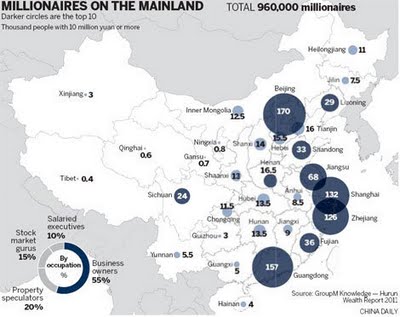(Ecns.cn) -- China had 960,000 individuals with personal wealth in excess of 10 million yuan ($1.56 million) in 2010, a 9.7% increase over the previous year.
According to the 2011 Hurun Wealth Report White Paper released this week by the Hurun Research Institute (HRI), a Shanghai-based group that tracks the nation's rich, the average age of the multimillionaires was 39, while 60,000 of them had more than 100 million yuan ($15.64 million) and averaged 43 years of age.
Where did the money come from?
It's hard to believe that in a country where one person in every 1,400 is a multimillionaire that there are millions of rural residents still earning less than $2 a day.
But thanks to strong gross domestic product (GDP) growth and a tremendous increase in property prices, China is now home to a bevy of wealthy elites.
In 2010, China's GDP increased by 10.3% and real estate prices soared, especially high-end properties. These two factors led to the mind-boggling number of rich people, which had increased sharply from only two years ago.
The trend has continued in 2011. China's most expensive apartments per square meter can be found at Beijing's Heritage Estate, or Diaoyutai Courtyard No. 7. These luxury units, located next to the Diaoyutai State Guest house built in the 1950s by Chairman Mao Zedong to host foreign leaders, were priced at more than 300,000 yuan ($46,920) per square meter. Home prices in Shanghai have also climbed, averaging 23,856 yuan ($3,732) per square meter in August 2011.
Although 98.7% of the entrepreneurs on the Hurun Rich List supposedly developed "healthy" enterprises, a small number had achieved their fortunes through dubious methods, according to a special Rich List Sin Bin Report released by the HRI in January. The report revealed that bribery, illicit capital market gains and fraud are the three main reasons entrepreneurs end up in the Sin Bin – which indicates that there is still even more wealth hidden in the Chinese economy.


















